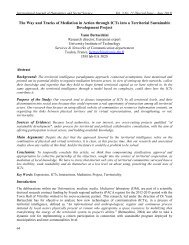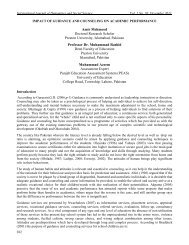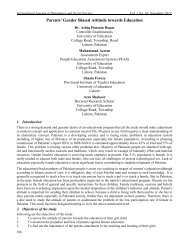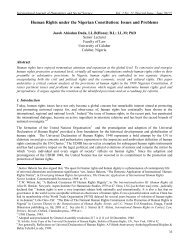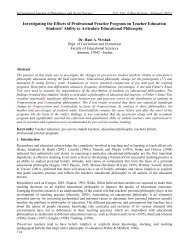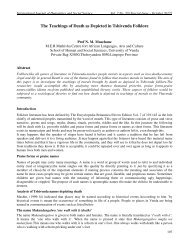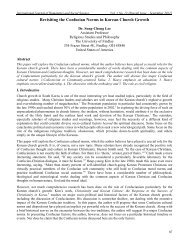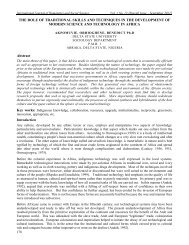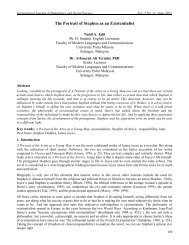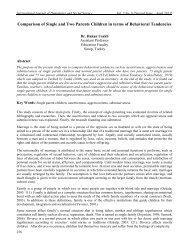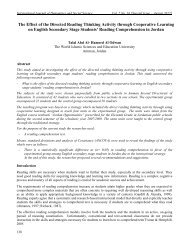Gender Influence on Access to Innovation Resources in Nigeria
Gender Influence on Access to Innovation Resources in Nigeria
Gender Influence on Access to Innovation Resources in Nigeria
Create successful ePaper yourself
Turn your PDF publications into a flip-book with our unique Google optimized e-Paper software.
© Centre for Promot<strong>in</strong>g Ideas, USA www.ijhssnet.com<br />
Blake and Hans<strong>on</strong> (2005) highlighted how gender is a relevant fac<strong>to</strong>r <strong>in</strong> such an appraisal, primarily prioritiz<strong>in</strong>g<br />
men as <strong>in</strong>nova<strong>to</strong>rs and envisi<strong>on</strong>ed mascul<strong>in</strong>e areas of <strong>in</strong>novati<strong>on</strong>. Nahl<strong>in</strong>der, (2010) argued that the<br />
<strong>in</strong>novativeness of women is hampered by low self-c<strong>on</strong>fidence and low prioritizati<strong>on</strong> of work issues over family or<br />
household issues. In another view, Crowden (2003) stated that “men are more likely <strong>to</strong> radically <strong>in</strong>novate than<br />
women because of their pers<strong>on</strong>al and social characteristics, thus bus<strong>in</strong>ess cycles <strong>in</strong>itiated by radical <strong>in</strong>novati<strong>on</strong>s<br />
can be deemed male-based”. In additi<strong>on</strong>, K<strong>in</strong>giri, (2010) cit<strong>in</strong>g World Bank, FAO and IFAD stated that gender<br />
<strong>in</strong>equalities occur <strong>in</strong> <strong>in</strong>novati<strong>on</strong> due <strong>to</strong> unequal or c<strong>on</strong>stra<strong>in</strong>ed access <strong>to</strong> resources and new technologies and<br />
access <strong>to</strong> <strong>in</strong>formati<strong>on</strong>, poor social networks, and literacy level.<br />
The <strong>in</strong>novati<strong>on</strong> studies, however, have not taken <strong>in</strong><strong>to</strong> account the views of women about their access <strong>to</strong> <strong>in</strong>novati<strong>on</strong><br />
resources and have not c<strong>on</strong>sidered empirically if access <strong>to</strong> <strong>in</strong>novati<strong>on</strong> resources could be <strong>on</strong>e of the reas<strong>on</strong>s why<br />
women and men’s c<strong>on</strong>tributi<strong>on</strong>s <strong>to</strong> <strong>in</strong>novati<strong>on</strong> differ. In <strong>Nigeria</strong>, the federal government has been striv<strong>in</strong>g <strong>to</strong><br />
promote equality of men and women <strong>in</strong> accordance with c<strong>on</strong>stituti<strong>on</strong>al provisi<strong>on</strong>s. This commitment was<br />
exemplified by the sign<strong>in</strong>g of the Nati<strong>on</strong>al Policy <strong>on</strong> Women <strong>in</strong> July 2000 after the failures of previous<br />
adm<strong>in</strong>istrati<strong>on</strong>s. The policy provides an opportunity and anchor for present and future <strong>in</strong>itiatives <strong>to</strong> address the<br />
barriers that limit the full participati<strong>on</strong> of <strong>Nigeria</strong>n women <strong>in</strong> various aspects of life. Also, government at various<br />
times and at various levels has <strong>in</strong>itiated and implemented credit schemes <strong>to</strong> empower marg<strong>in</strong>alized entrepreneurs<br />
like women (Eriki and Okafor, 2003; Nwoye, 2011). The efforts of the government <strong>to</strong> promote gender equality<br />
and women empowerment is complemented by the work of vibrant NGOs, women groups and coaliti<strong>on</strong>s that have<br />
sprung up <strong>to</strong> address the needs of women. <str<strong>on</strong>g>Gender</str<strong>on</strong>g> equality works <strong>to</strong>ward end<strong>in</strong>g discrim<strong>in</strong>ati<strong>on</strong> by provid<strong>in</strong>g<br />
equal opportunities or ensur<strong>in</strong>g equality of c<strong>on</strong>diti<strong>on</strong>s for men and women. Equality is c<strong>on</strong>sidered <strong>to</strong> mean that<br />
every<strong>on</strong>e receives the same benefit, share or treatment regardless of their situati<strong>on</strong> and circumstances. Therefore,<br />
the purpose of this paper is <strong>to</strong> advance knowledge as <strong>to</strong> the relati<strong>on</strong>ship between access <strong>to</strong> resources and<br />
<strong>in</strong>novative ability <strong>in</strong> a country where efforts are be<strong>in</strong>g made <strong>to</strong> promote gender equality. This has important<br />
implicati<strong>on</strong>s for the understand<strong>in</strong>g of the resources that promote and drive <strong>in</strong>novati<strong>on</strong>. The specific objectives that<br />
motivated this study <strong>in</strong>clude:<br />
i. To ascerta<strong>in</strong> if men entrepreneurs are actually more <strong>in</strong>novative than women entrepreneurs <strong>in</strong> <strong>Nigeria</strong>.<br />
ii. To <strong>in</strong>vestigate if disparities exist between women and men entrepreneurs <strong>in</strong> access<strong>in</strong>g <strong>in</strong>novati<strong>on</strong><br />
resources <strong>in</strong> <strong>Nigeria</strong>.<br />
iii. To determ<strong>in</strong>e if gender has a higher significant impact <strong>on</strong> <strong>in</strong>novati<strong>on</strong> performance than <strong>in</strong>novati<strong>on</strong><br />
resources.<br />
The follow<strong>in</strong>g hypotheses were exam<strong>in</strong>ed:<br />
i. Ho 1 : Women entrepreneurs have equal access <strong>to</strong> all <strong>in</strong>novati<strong>on</strong> resources as men entrepreneurs <strong>in</strong><br />
<strong>Nigeria</strong>.<br />
ii. Ho 2 : <str<strong>on</strong>g>Gender</str<strong>on</strong>g> has a higher significant impact <strong>on</strong> <strong>in</strong>novati<strong>on</strong> performance than <strong>in</strong>novati<strong>on</strong> resources.<br />
2. Literature Review<br />
2.1 C<strong>on</strong>ceptualiz<strong>in</strong>g Innovati<strong>on</strong><br />
The c<strong>on</strong>cept of <strong>in</strong>novati<strong>on</strong> has been def<strong>in</strong>ed <strong>in</strong> various ways. Ramadani and Gerguri (2011) def<strong>in</strong>ed <strong>in</strong>novati<strong>on</strong> as<br />
“a process of transform<strong>in</strong>g new ideas and new knowledge <strong>in</strong><strong>to</strong> new products and services”. In the views of<br />
Baregheh et al (2009) <strong>in</strong>novati<strong>on</strong> is a multi-stage process whereby organizati<strong>on</strong>s transform ideas <strong>in</strong><strong>to</strong><br />
new/improved products, services or processes <strong>in</strong> order <strong>to</strong> advance, compete and differentiate themselves<br />
successfully <strong>in</strong> the marketplace. In dist<strong>in</strong>guish<strong>in</strong>g between creativity and <strong>in</strong>novati<strong>on</strong>, Weihrich and Ko<strong>on</strong>tz (2005)<br />
def<strong>in</strong>ed creativity as “the ability and power <strong>to</strong> develop new ideas while <strong>in</strong>novati<strong>on</strong> is the use of these ideas”.<br />
Adeyeye (2008) differentiated between <strong>in</strong>venti<strong>on</strong> and <strong>in</strong>novati<strong>on</strong> by def<strong>in</strong><strong>in</strong>g <strong>in</strong>venti<strong>on</strong> as “the act of develop<strong>in</strong>g,<br />
design<strong>in</strong>g or creat<strong>in</strong>g someth<strong>in</strong>g that has not existed before while <strong>in</strong>novati<strong>on</strong> is <strong>in</strong>venti<strong>on</strong> and/or applicati<strong>on</strong> of<br />
new knowledge <strong>in</strong> a particular area”. This means that <strong>in</strong>venti<strong>on</strong>s can be seen as <strong>in</strong>novati<strong>on</strong>s but <strong>in</strong>novati<strong>on</strong>s are<br />
not necessarily <strong>in</strong>venti<strong>on</strong>s because <strong>in</strong>novati<strong>on</strong>s may be a l<strong>on</strong>g established ideas or products <strong>in</strong>volv<strong>in</strong>g a new<br />
applicati<strong>on</strong>. Innovati<strong>on</strong> therefore can be c<strong>on</strong>ceptualized as the development and/or applicati<strong>on</strong> of new products,<br />
methods of producti<strong>on</strong>, processes and services.<br />
217




